Tags
Phapokklao Road in Chiang Mai is a wataholic’s wet dream. You’ll find what may be the city’s most famous and most visited temple, Wat Chedi Luang, there. And Wat Phan Tao with it’s striking teakwood wiharn is right next door. For many visitors, those two temples alone are reason enough to visit the street. And for many visitors those two wats alone are enough to fill their temple visiting needs. But if you are like me and there is no such thing as too many wats to visit, just keep walking south and you’ll stumble upon more than you could possibly tour in one day. No problemo. That’s what tomorrows were made for.
Though none of the dozen or so temples along Phapokklao Road are close to the size of Wat Chedi Luang – and in fact some are so small they are easy to miss – several are well worth your time either because of the uniqueness of their structures or their importance to the local community. Wat Chang Taem is one of those. The entire complex is only 800 square meters. It has a wiharn built in the Lanna style, a medium sized chedi, and two easy to overlook halls for the temple’s monks. Plus a bell tower. Nothing spectacular to draw you in other than that it looks quite new. At least as far as Buddhist temples in Chiang Mai go. But Wat Chang Taem houses one of the city’s most important Buddha images. Yes, looks can be deceiving.
Originally named Wat Chang Thong Taem Kaew Kwang Ta Chang Ping Chai, Wat Chang Taem is approximately 700 years old. Not that you’d know it by looking at the temple. It’s had a face-lift that Joan Rivers could only wish for. The wiharn’s exterior is blindingly white, with its fanciful Naga flanking the main entrance it is reminiscent of Chiang Rai’s White Wat. And inside the floor is made of gorgeous marble tiles offset by oriental carpets with a crystal chandelier hanging above. It’s one of the city’s more pristine temples, even the chedi – which encompasses the wat’s original stupa – gleams in the sun drawing your eye to the bas relief details of the Chinese Zodiac animals done in gold around its base.
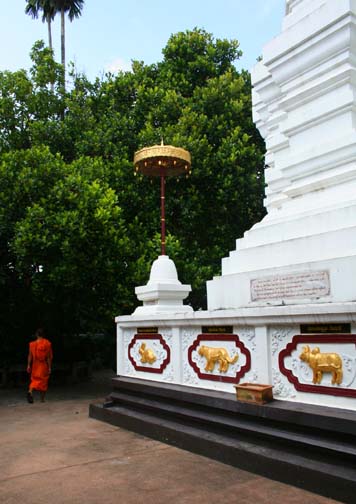
At the chedi’s base a sign explains the wat’s history, though in such broken English it may as well be in Thai.
Because I prefer discovering wats by chance, thanks to its upscale and well-tended look on my first visit I assumed Wat Chang Taem was a new temple built by and for the hi-so members of the nearby community. And I was more taken with the Hindu-looking garuda fronting the altar than I was with the Buddha statues behind it. That night back at my hotel Google informed me how wrong I was. And pointed out what I had missed.
Wat Chang Taem’s principal Buddha image is the Fon Saen Ha Buddha, or the Buddha of One Hundred Thousand Showers. During the city’s annual Inthakin festival each spring it is moved in a grand parade on a specially made chariot to Wat Chedi Luang where it blessed with water and placed in the courtyard of the City Pillar. Known as Tham Boon Khan Dok, or Flower Bowl Blessing, this is the opening ceremony of the seven day festival during which the city’s faithful place offerings of flowers, candles, and joss sticks in each of twenty-eight bowls laid out on mats in the temple. The belief behind this is that those who take part in the ceremony will be blessed with good health and that Chiang Mai’s rain will fall at the right time of the season.
The highly revered Fon Saen Ha Buddha is made of bronze and is more than 1,000 years old. Originally, it was located in neighboring Lamphun during Queen Chamthewi’s reign. During the mid-fifteenth century Chiang Mai’s King Tilokaraja waged war with Lamphun, and legend has it that every building in the city was burned to the ground except for one temple. The Lanna King, touring what was no longer a city, found the Fon Saen Ha Buddha and the Pra Kaew Khao Buddha at that temple and “invited’ them to accompany him back to Chiang Mai. The Pra Kaew Khao Buddha was enshrined at Wat Chiang Man, the Fon Saen Ha Buddha made its new home at Wat Chang Taem where he is believed to bring wealth and happiness to the people of Chiang Mai. For the people of Lamphun, not so much.
Related Posts You Might Enjoy:



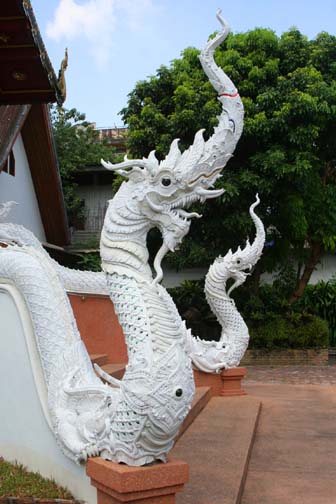
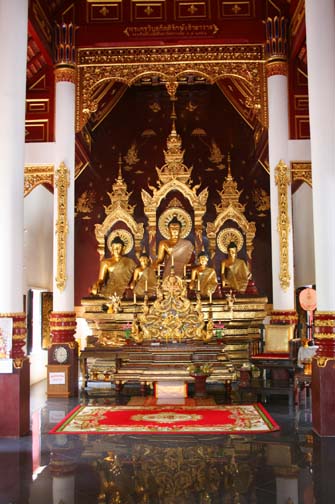
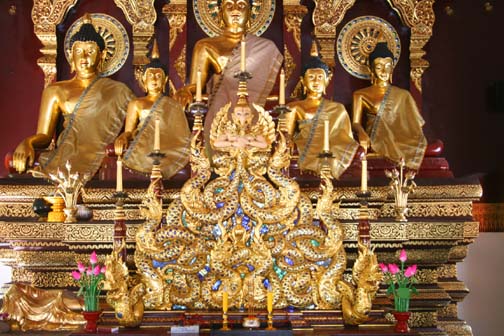
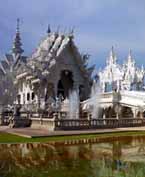
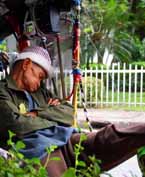

I have noted this one on my list of things to do when next in Chiang Mai !
Wat Jed Whatevers is just down the street too – it’s the one with the cool pond and old rickety bridge so don’t miss that one either!